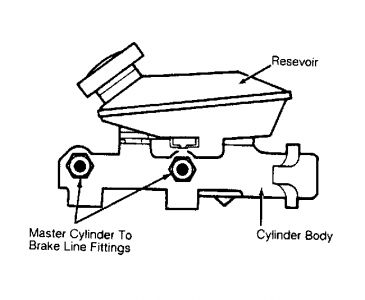MANUAL BLEEDING
Clean master cylinder cap and surrounding area. Remove cap.***** models are equipped with dual-type master cylinder.**** Bleed primary and secondary systems separately. Loosen primary or secondary master cylinder hydraulic line fitting. See Fig. 1 .
Fig. 1: Bleeding Master Cylinder (Typical)
Courtesy of FORD MOTOR CO.
Wrap a cloth around brake lines to absorb escaping brake fluid. Slowly push brake pedal down to force out air. With pedal fully depressed, tighten fittings to prevent air from being sucked into master cylinder when pedal is released. Release pedal.
Repeat procedure until air is completely purged from master cylinder. When all air has escaped, tighten fittings with pedal down. Release pedal, and depress again. If pedal is not firm, repeat bleeding procedure.
Attach a rubber drain hose to bleeder fitting on front of master cylinder. Submerge hose in small container half-filled with clean brake fluid. Open bleeder fitting. Loosen bleeder fitting about3/4 turn. Slowly push down brake pedal completely.
Close bleeder fitting, and return pedal to fully released position. Repeat procedure until all air is purged from master cylinder. Repeat procedure at bleeder fitting on Rear Anti-Lock Brake Electrohydraulic RABS Valve, each wheel cylinder and caliper. See Fig. 2 . See BLEEDING SEQUENCE table under BLEEDING SEQUENCE. When bleeding is complete, fill master cylinder to proper level.

Saturday, December 26th, 2020 AT 2:30 PM
(Merged)
